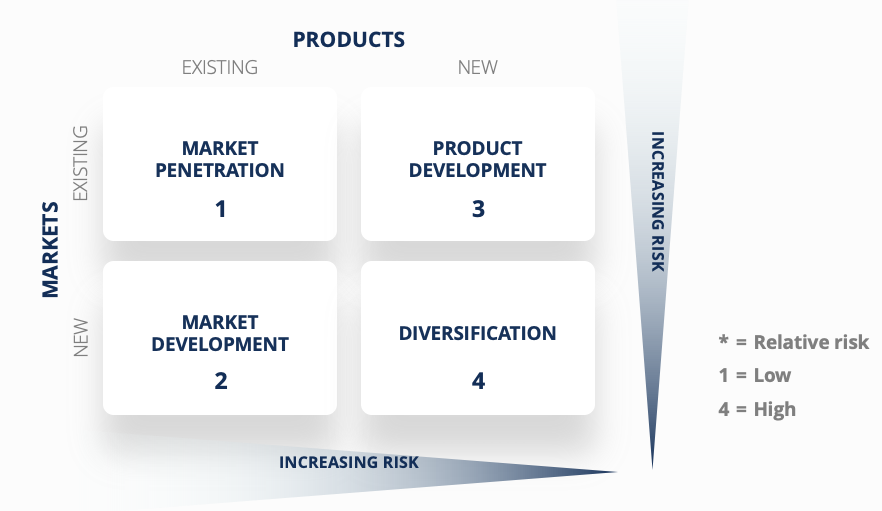Businesses employ a number of growth strategies to meet their goals and objectives. Every company wants to grow, beat their competitors, and become the market leader. But you can’t do that when your business is stagnant.
A good business growth strategy doesn’t just increase market share. It helps them improve their processes and daily workflow. It fosters a culture of creativity and innovation. Moreover, it enables them to integrate newer technologies that can help them leap forward.
These strategies are a vital part of making a business more sustainable. Without growth, a business is left in the hands of the market. If the market shifts suddenly, it can become a crisis for a stagnant business with no way to get out.
This article explains what business growth strategies are and explains the most effective strategies you can implement for your business.
Table of Contents
What Is a Business Growth Strategy?
A business growth strategy is a comprehensive proposal that defines a detailed plan of action to grow a business and expand operations. When businesses want to increase revenue and profits and capture a larger share of the market, they need to grow. And for this, they need a detailed strategy that streamlines exactly what they need to do.
To create an effective strategy, businesses need to analyze their financial situation, identify opportunities in the market, and evaluate the risks. This requires multiple departments and executives to collaborate with each other toward a common goal.
There are several components to a business growth strategy. The most important thing is the goal. This is what the business aims to achieve with the strategy. Another important component is all the people involved in the strategy. The third component is the product they’re going to use or create to fuel growth. Lastly, there is the action plan, which includes all the steps and tactics they’re going to employ.
Top Business Growth Strategies
There are many growth strategies that businesses can adopt to expand their business, create value, tap into a new market, or achieve whatever their strategic goals are. The type of strategy that’s best for you depends on your type of business, the industry you’re in, and what you aim to do.
Here are some of the most effective growth strategies for all kinds of businesses. The first four strategies are some of the most effective frameworks for growth and can be summarized on the Ansoff Matrix, as shown below.

Market Penetration
This is the most common type of growth strategy. It entails increasing your market share and customer base. To understand market penetration better, imagine there are only two companies in a niche market. Whatever customers Company A has acquired are lost to Company B. A market penetration strategy for Company B would be to capture Company A’s customers for themselves.
The essence of market penetration is to use your existing products to penetrate your existing market. The risk is low with this strategy because you’ve already established yourself in the market. You need to choose your market penetration strategy to minimize the already low risk. One of the most common strategies here is lowering prices. You can lower your product prices just a tad bit below your competitor’s to attract their customers.
Another great strategy is to acquire your competitor directly. This is riskier because you’ll also be taking on their assets and liabilities. But it’s also very effective, as you directly absorb their entire customer base and their market share. Increasing your marketing efforts is an aggressive penetration strategy. It helps increase your brand awareness, and if you can communicate your value to your competitors, you can capture them.
Market Development
Market development is similar to market penetration, with one difference. In this strategy, you’re selling an existing product to a new market. In this growth strategy, companies don’t develop a new product for a new market but use the same product to target new customers that they haven’t catered to before. The most simple example of a market development strategy is a local company going global with their products and services. This is called geographic expansion.
To develop a market development strategy, you need to go back to the basics. This is the market research that you conducted before targeting your existing customers. This research will tell you which other types of audiences are also interested in your products. When you’ve selected a new audience, you have to strategize the best ways to target them.
Another type of market development is demographic expansion. In this strategy, companies don’t go out of their local market but target a new demographic in their locality. For example, a company that previously only targeted adults over the age of thirty is now using social media to target young adults aged between twenty and thirty.
Product Development
The third growth strategy on the Ansoff Matrix is product development. In this strategy, companies develop a new product for their existing market. Usually, companies only go for a product development strategy when they think they’ve reached a plateau with their current product in the existing market. If you think that your products have reached their maximum market share and there is no potential for growth, product development is a good step.
There are two ways you can go about a product development strategy. The first is to develop an entire new product. This approach takes the most time and resources because you have to invest a lot in research and development. The other approach is to evolve your current product with new features and present it as a new product. This takes less time, but there is still a lot of R&D involved.
Developing and implementing a product development strategy may be vastly different for every company. It all depends on the scale of the project and how much companies are willing to invest in R&D. Some companies tend to outsource product development so they can focus on in-house projects. In every kind of product development strategy, research and customer needs are the core components.
Diversification
Diversification is a growth strategy where a company introduces a new product or line for a new market. This is the riskiest strategy in the Ansoff Matrix, as companies can’t accurately predict how the new market will react to an entirely new product. But the benefits of such a strategy are also high. It allows companies to innovate, target a diverse audience, and increase their profitability.
There are many types of diversification strategies. Horizontal diversification is when a company introduces new products that are completely unrelated to their current product mix. Concentric diversification involves creating a product that is related to their current product mix and usually complements it. Concentric diversification is focused on the existing market. Conglomerate diversification involves making new products unrelated to the existing products and the market. Typically, it involves setting up a separate business under the parent company.
One of the biggest examples of diversification can be taken from Amazon. Initially an ecommerce company, Amazon has diversified into a number of different industries, both related and unrelated to their initial offering. Their brick-and-mortar stores are an example of concentric diversification. Whereas, their home assistant, Alexa, is an example of conglomerate diversification.
Market Segmentation
Although market segmentation isn’t typically a growth strategy, most companies still consider it one, and it has become popular. In this strategy, companies divide their existing market into smaller segments based on characteristics. The point is to group similar customers together so you can personalize your other strategies and target them better.
Segmentation can be done based on a number of different factors. A popular factor is demographics. These include characteristics like age, gender, race, education, income, marital status, employment, family size, and more. It’s obvious that you wouldn’t market a product to an elderly person the same way you would to a teenager.
Another way to segment your audience is according to their behavior. You can group people together based on their interests, activities, and buying behaviors. Segmenting your audience enables you to target them on a more personal level. You can create effective marketing campaigns that they will relate to. As such, you can increase your Average Order Value (AOV) and encourage them to make repeat purchases.

Strategic Partnerships
Strategic partnerships are a type of growth strategy in which two or more businesses come together to share resources and help each other grow. Businesses that enter strategic partnerships typically aren’t competitors.
Most partnerships involve businesses in the same industry with similar products. Their products can also be complementary. But there are partnership examples where businesses from different industries have helped each other, and these are equally beneficial.
There are many types of partnerships. Which type suits your business the most is defined by your goals and the kind of growth you’re looking for. If you want to increase sales and revenue, a marketing partnership is the best choice. A great example of this type of strategic partnership is Nike and Apple.
Nike and Apple started their partnership a very long time ago, and it is still operational and a huge success. With the partnership, users could bring music from Apple to their customized workouts from Nike. Products from both companies can connect with each other to give users an out of world experience.
Acquisition
This growth strategy is rather aggressive. As the name suggests, it involves acquiring another business to support or grow your own. Companies do this when they want to gain more control of the market, eliminate competitors, or streamline their supply chain. All of these goals lead to a boost in profitability.
Companies with such a strategy acquire businesses in the same industry that have similar or complementary products. The most popular type of acquisition strategy is when companies buy a competing business. This gives them a significant advantage in the market because their competition doesn’t exist anymore. This strategy is called horizontal acquisition.
Backward acquisition is when companies purchase a company that is a part of their supply chain. It gives them more control over the supply chain. They can produce the materials for their products themselves. It significantly reduces their costs. It also gives them more opportunities to innovate and create new products at a lower cost.
Business Growth Strategies: Foster Growth At Your Workplace
Business growth is the key to long-term success. It allows companies to expand their reach, increase their market share, and generate higher profits. By continuously growing and adapting to market demands, businesses can stay ahead of their competitors and maintain a strong position in the industry.
Additionally, business growth opens up new opportunities for innovation, partnerships, and strategic collaborations, allowing companies to diversify their offerings and stay relevant in a rapidly changing marketplace.
How do you plan on growing your business? Talk to us in the comments below!
For more similar blogs, visit EvolveDash today!
FAQs
- How do you measure the success of a business growth strategy?
Businesses track key performance indicators (KPIs) like revenue growth, customer acquisition, and market share.
- What are the risks of implementing a growth strategy?
Risks include financial strain, operational challenges, and potential market misalignment.
- How long does it take to see results from a growth strategy?
Timelines vary, but most strategies take months or even years to show significant impact.
- Can small businesses use the same growth strategies as large corporations?
Yes, but they may need to scale down strategies and focus on cost-effective approaches.
- How can businesses sustain growth in a competitive market?
By continuously innovating, adapting to market trends, and improving customer relationships.



















